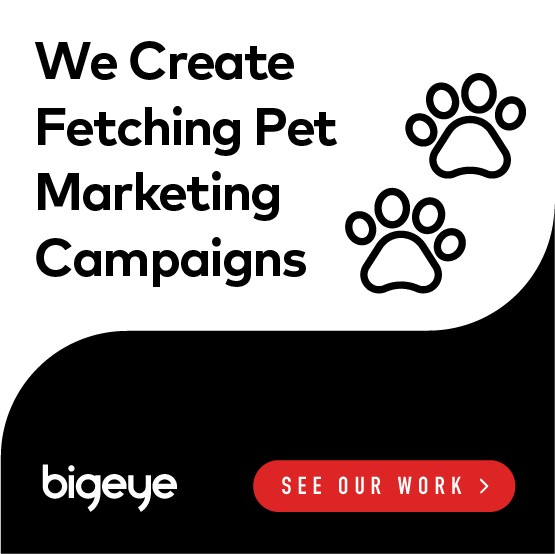
Find out how the coronavirus pandemic has impacted pet product sales, and how your pet product marketing can take advantage of opportunities.
In the past, marketers thought of pet product marketing as reliably recession-resistant. According to Pet Food Industry, an industry journal, that proved true both after 911 and during the Great Recession of 2008. In contrast, industry forecasters do expect to see at least a temporary drop in some pet product sales during the coronavirus crisis.
Of course, pet owners still need to feed and care for Fluffy and Fido. Because of this, not all kinds of products will suffer, and the market should rebound by next year. In fact, some brands have continued to do quite well during the crisis. Take a minute to understand the state of the current market and how a pet product marketing agency or retailer can appeal to customers.
Challenges to pet product marketing during the coronavirus
These are some recent recent forecast for U.S. retail sales for pet product marketing and sales that Pet Food Industry published:
- Post-pandemic forecasts assume a 17 percent drop in U.S. retail sales of pet products for 2020 to 2021. Before the pandemic, those same forecasts predicted a five percent increase.
- If true, these declines will translate into about $18 billion less revenue in 2020 than in 2019.
- The forecasts do predict that the market will begin to recover in 2021. This rebound underscores the strength of the market for pet food and other pet products in the United States.
Pet product marketing opportunities during the coronavirus crisis
While forecasters expect pet product marketing to struggle during the next year, some kinds of products may not suffer as much. For example:
- Industry analysts believe non-medical pet services, vet services, and non-food pet supplies will have the largest drops.
- On the other hand, these same forecasters expect non-discretionary product sales to maintain modest growth.
Non-discretionary products include such necessary items as pet food and cat litter. Even with these need-to-have items, expect to see consumers looking for value by turning more to sales and in some cases, store brands.
Pet ownership may actually increase during COVID-19
Packaged Facts provides industry research for several industries, including pet products. Their research director, David Sprinkle, believes that U.S. pet ownership might even increase during this crisis. He said that happened during the Great Recession of 2007 to 2008. It’s even more likely to happen now because pets can provide comfort and companionship during these times of social isolation measures. As more people have switched to remote work, they may also feel they have more time to care for a pet.
Surges expected for eCommerce pet product sales
Even before the current crisis, eCommerce sales of pet products had begun to grow at a steady pace. As with other packaged goods, the online part of the market has continued to climb during the outbreak. Consumers may feel reluctant to leave their homes to shop as much and might even have trouble finding their favorite brands reliably stocked in stores.
In addition, once pet owners find an eCommerce retailer who offers competitive prices, they often decide that ordering pet products online provides them with convenience and affordability. In any case, Packaged Facts expects the online share of the market to reach 24 percent in 2020 and over 26 percent by 2021.
Maintaining and growing sales during the coronavirus pandemic
A pet product agency can take some comfort in the potential growth in pet ownership and a strong demand for such essential pet supplies as food and cat litter. While other niches may slump somewhat, they won’t completely drop off and are expected to resume growing again by next year.
Based on these insights for the current state of the industry, businesses can take some steps to position their own pet business better. For instance, good tactics might include offering competitive prices for essential pet products to attract and keep customers. Those same customers are still likely to consider some discretionary pet purchases.
Maintaining or creating pet products brand loyalty
At least when it comes to pet food, most owners tend to remain pretty loyal to certain brands. If their pet appears to like a certain kind of food and that food keeps them healthy, their owners will generally keep buying it. As most pet owners know, switching brands can take a period of adjustment, so that’s something most people would rather avoid.
A survey from Civic Science found that even during the pandemic, just about three-quarters of pet owners had more concerns about pet food quality than price. As an interesting note to help develop buyer personas, women, people who cook a lot for themselves, and older people appear most concerned about quality. Dog owners seemed somewhat more concerned than cat owners.
People who value quality the most will tend to turn to online retailers; however, people who also value patronizing locally owned businesses also tend to care a lot about quality. This also suggests that locally owned business could have a good chance to grow their business with online ordering options.
To dig a little deeper, the survey also asked these pet owners some specific questions about their buying behavior:
- Brand vs. price: Where 40 percent said brand mattered more than price, only 14 percent said price mattered more. To be fair, almost half of the survey respondents said that they considered price and brand just about equally important. Unsurprisingly, typical consumers would rather save money but not at the expense of quality.
- Sources: About 55 percent of the respondents said they bought their pet food at the store. Of these, 43 percent shopped at either a grocery or discount store and 28 percent purchased from a local or chain pet store. Online sales from Amazon and other online retailers captured about 29 percent of sales.
In conclusion, pet owners do tend do demonstrate brand loyalty. On the other hand, most of these consumers would prefer to find a good deal that won’t make them sacrifice quality. Also, while the number of online shoppers keeps increasing, a majority of pet owners still tend to pick up pet products locally, very often when they’re doing their own shopping.
Consumer pet product shopping concerns
Also, the Civic Science survey asked if pet owners shopped online more now because of the pandemic. About 17 percent said that they did, but seven percent said they shopped online less. Over a third of pet owners replied that they had concerns about obtaining enough pet food during the crisis and almost two-thirds said they had stocked up with enough products to last for at least three weeks.
Some of the steadily increasing demand for essential pet products may come from people stocking up because they have concerns about finding their favorite brands on the shelves. Pet product marketing might do well to focus upon ensuring consumers that they will provide a steady, reliable supply of high-quality pet food to ensure and increase brand loyalty.
Online pet product marketing companies weathering the coronavirus well
Because of social distancing, online shopping for all kinds of products has enjoyed rapid growth during the pandemic. In order to improve pet product marketing for any particular retailer or brand, it helps to look at companies that have demonstrated the most growth. For example, Chewy has recently announced they would hire over 6,000 people to handle the surge in demand at fulfillment centers.
This online retailer has had to contend with higher costs both for labor and for putting additional safety measures in place to protect employee health. On the other hand, Chewy doesn’t operate retail stores at all, so they haven’t had to worry about any fallout from decreased foot traffic or even closed stores.
So, what gives Chewy a competitive advantage for pet product marketing over many other online retailers? Even just before the pandemic, Motley Fool called Chewy a “millionaire making” stock. Even though many marketers consider Amazon unbeatable for online sales, Chewy has managed to take the largest online retail in the world on. A lot of people might regret failing to take the Motley Fool’s advice to buy Chewy stock back in January, but there’s still time to learn from this example.
What is Chewy’s competitive advantage over other online retailers?
Chewy concentrated only upon pet product marketing and nothing else. Mostly, Chewy has managed to stay even with Amazon for prices, selection, reliability, and convenience. Both of these large retailers also have the resources to budget for competitive keywords and other marketing tactics.
Chewy beat Amazon by going the distance to provide exceptional customer service. Examples include hand-written welcome and sympathy cards and even sometimes, hand-drawn portrait photos. Typically, Chewy also employs pet owners who also own pets, so they’re very engaged with the market.
While Chewy has increased private-label product sales, they mostly sell other brands. They have worked on developing their private-label pet packaging design with lots of images of cute, happy pets and big lettering that explains the product’s benefits. You can actually find images of these packages shared quite a bit on Pinterest and other sites. Still, it will probably take some time to get many brand-loyal pet owners to switch, even if they can save money.
Mostly, the company accepts low margins or even losses upon first-time sales because they offer lots of coupons to encourage new customers. They work to profit by retaining customers with discounts for enrolling in the autoship program and by steadily increasing the types and brands of products they sell.
The company has found that repeat customers tend to buy more after having positive experiences with their first purchases. Obviously, Chewy also promotes the popular idea that pets are family members and certainly not just creatures. Their customers tend to identify with the brand because they believe the brand identifies with them.
The future of pet product marketing after coronavirus
Americans have proven famously loyal to their pets, even during economic downturns. Very often, pet owners will compromise on themselves before sacrificing their pet’s needs. Previous economic downturns have demonstrated this quite well. While many pet owners still shop locally, they’re increasingly turning to eCommerce pet stores for convenience, selection, and pricing. Smaller or newer online retailers may have to struggle to compete with giants like Amazon to get a share of new sales.
Providing great service and high-quality products at competitive prices can help. Pet product marketing can attract and retain new customers with price promotions, loyalty programs, and discounted autoshipping offers. By taking a page from Chewy, going the extra mile to prove that a company cares about pets and their pet parents can provide a competitive advantage that won’t necessarily require a huge investment.




